The MX63 and MX63L microscope systems from EVIDENT are enhanced for top-quality inspections of wafers measuring as large as 300 mm, circuit boards, flat panel displays, and other large samples. The systems’ modular design enables users to pick the components they need to customize the system to suit their application.
The MX63 and MX63L microscope systems are ergonomic and user-friendly and can help increase throughput while keeping inspectors comfortable when performing their work. These systems can be combined with EVIDENT Stream image analysis software, thus ensuring that the entire workflow, from observation to report creation, can be simplified.

Functional
The MX63 and MX63L microscope systems are designed to match the ergonomic and safety requirements of the electronics sector with added functionality to improve analysis capabilities.
Observation and Analysis Tools
1. Leading-Edge Analysis Tools
The MX63 series’ versatile observation abilities deliver clear, sharp images so users can consistently detect defects in their samples. New illumination methods and image acquisition options within EVIDENT Stream image analysis software offer users more selections for assessing their samples and documenting their findings.
The Invisible Becomes Visible: MIX Observation and acquisition
The MIX observation technology creates unique observation images by joining darkfield with another observation technique, such as fluorescence, brightfield, or polarization. MIX observation enables users to see defects that are difficult to observe using conventional microscopes. The circular LED illuminator used for darkfield observation has a directional darkfield function where just one quadrant is illuminated at a given time. This decreases a sample’s halation and is beneficial for visualizing a sample’s surface texture.
Structure on semiconductor wafer

Left: The IC pattern is unclear. / Middle: The wafer color is invisible. / Right: Both the wafer color and IC pattern are clearly represented.
Photoresist residue on a semiconductor wafer

Left: The sample itself is invisible. / Middle: The residue is unclear. / Right: Both the IC pattern and residue are clearly represented.
Easily Create Panoramic Images: Instant MIA
With multiple image alignment (MIA), users can stitch images together rapidly and easily just by moving the KY knobs on the manual stage—a motorized stage is not required. EVIDENT Stream software uses pattern recognition to produce a panoramic image, giving users a broader field of view.

Instant MIA image of a coin
Create all-in-focus images: EFI
The Extended Focus Imaging (EFI) function within EVIDENT Stream captures images of samples whose height goes beyond the depth of focus of the objective and stacks them together to form one image that is all in focus. EFI can be performed with either a manual or motorized Z-axis and creates a height map for easy structure visualization. It is also possible to build an EFI image while offline within Stream Desktop.

Stud bump on an IC chip
Capture Both Bright and Dark Areas Using HDR
Using advanced image processing, high dynamic range (HDR) modifies for differences in brightness within an image to minimize glare. HDR enhances the visual quality of digital images thus helping to create professional-looking reports.
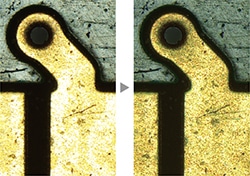
Left image: Some areas are glaring. / Right image: Both dark and bright areas are clearly exposed by HDR.
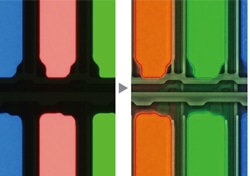
Left image: The TFT array is blacked out due to the brightness of the color filter. / Right image: The TFT array is exposed by HDR.
From Basic Measurement to Advanced Analysis
Measurement is vital for quality and process control and inspection. With this in mind, even the entry-level EVIDENT Stream software package includes a comprehensive menu of interactive measurement functions, with all measurement results saved with image files for additional documentation. Furthermore, the EVIDENT Stream Materials Solution provides an intuitive, workflow-oriented interface for intricate image analysis. At the click of a button, image analysis operations can be performed precisely and quickly. With a substantial reduction in processing time for repeated operations, operators can focus on the inspection at hand.
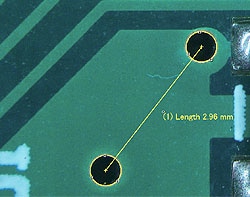
Basic measurement (pattern on a printed circuit board)
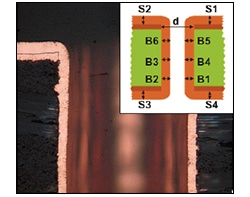
Throwing power solution (Cross section of a through hole of PCB)
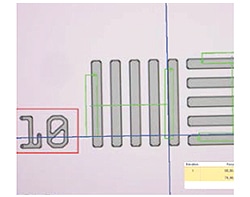
Automatic measurement solution (Wafer structure)
Efficient Report Creation
Creating a report can frequently take longer than capturing the image and taking the measurements. EVIDENT Stream software offers smart report creation to repetitively produce smart and refined reports based on pre-defined templates. Editing is simple to do and reports can be exported to Microsoft Word or PowerPoint software. Furthermore, EVIDENT Stream software’s reporting function enables digital zooming and magnification on developed images. Report files are a practical size for easier data exchange by email.

Stand-Alone Camera Option
With a DP22 or DP27 microscope camera, the MX63 series turns into an advanced stand-alone system. The cameras can be regulated via a compact box that needs only limited space, helping users capitalize on their laboratory space while still capturing clear images and making standard measurements.

2. Advanced Designed to Support Cleanroom Conformity
The MX63 series is engineered to work in a cleanroom and has features that help decrease the risk of damaging or contaminating samples. The system has an ergonomic design that helps users be comfortable, even during extended use. The MX63 series complies with global specifications and standards, including CE, SEMI S2/S8, and UL.
Optional Wafer Loader Integration - AL120 System*
An optional wafer loader can be linked to MX63 series to securely transfer both silicon and compound semiconductor wafers from a cassette to the microscope stage without using wands or tweezers. Well-established performance and reliability enable safe, efficient front and back macro inspections while the loader helps enhance productivity in the laboratory.
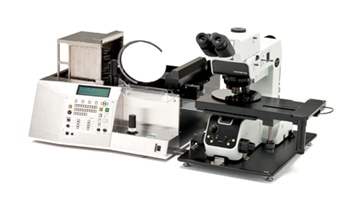
MX63 combined with the AL120 wafer loader (200 mm version)
* AL120 is not available in EMEA.
Fast, Clean Inspections
The MX63 series enables contamination-free wafer inspections. All motorized parts are accomodated in a shielded structure, and antistatic processing is applied to the microscope frame, breath shield, tubes, and other parts. The rotation speed of the motorized nosepieces is faster and safer than physical nosepieces, minimizing the time between inspections while keeping the operator's hands below the wafer, decreasing potential contamination.

Antistatic breath shield
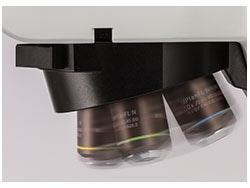
Motorized nosepiece
System Design Achieving Efficient Observations
The XY stage is capable of both fine and coarse stage movements because of the combination of an integral clutch and the XY knobs. The stage helps perform observations efficiently, even for large samples, such as 300 mm wafers.
The tilting observation tube’s wide range enables operators to sit in a comfortable posture at the microscope.
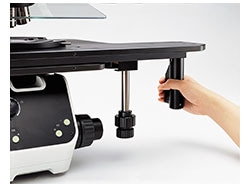
Stage handle with built-in clutch
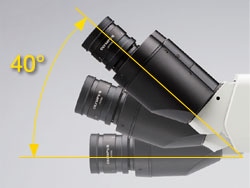
The tilting observation tube providing comfortable posture
Accepts All Wafer Sizes
The system operates with a number of types of 150–200 mm and 200–300 mm wafer holders and glass plates. In case the size of the wafers change on the production line, the microscope’s frame can be altered at minimal cost. With the MX63 series, different stages can be used to house 75 mm, 100 mm, 125 mm, and 150 mm wafers on the inspection line.
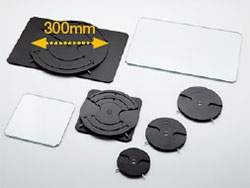
Wafer holders and glass plates
User-Friendly
The simplified microscope settings make it easier for users to make modifications and reproduce system settings.
Intuitive Microscope Controls: Comfortable and Easy to Use
The microscope’s settings are easy to operate, making it simpler for users to make modifications and replicate system settings.
Find the Focus Quickly: Focus Aid
Inserting a focus aid in the optical path enables easy and accurate focusing on low-contrast samples, such as bare wafers.
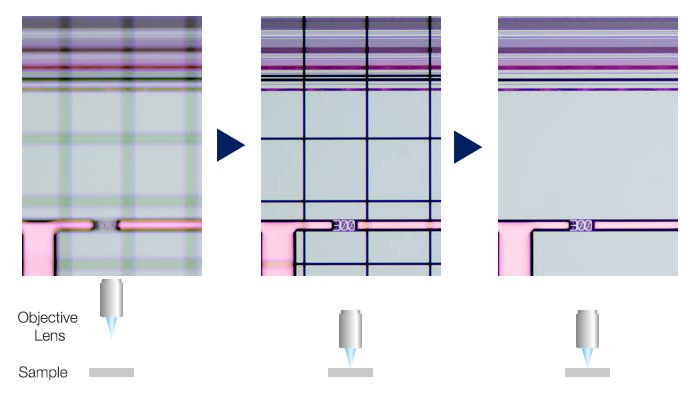
Left image: The grid indicates the image is out of focus. / Middle images: The grid assists focusing. / Right image: An in-focus image can be easily obtained.
Ergonomic Controls for Quicker, More Comfortable Operation
The controls for altering the objective and regulating the aperture stop are located low and in the front of the microscope so users do not have to let go of the focusing knobs or move their head away from the eyepieces during operation.

Centralized microscope operation / Hand SW / Snapshot button
Faster Observations via the Light Intensity Manager and Automatic Aperture Control
In standard microscopes, users have to fine-tune the light intensity and aperture for each observation. The MX63 series enables users to fix the light intensity and aperture conditions for various magnifications and observation techniques. These settings can be easily recalled, helping users maintain optimal image quality and save time.
Light Intensity Manger
| |
 |
| Conventional Light Intensity |

The image gets too bright or dark when changing magnification or observation method |
| Light Intensity Manager |

The light intensity is automatically adjusted to produce the optimal image when changing magnification or observation method. |
Automatic Aperture Control
 |
| Maximum aperture: Higher resolution |
Minimum aperture: Higher contrast and larger depth of field |
 |
Advanced Imaging Technology- Image Quality
EVIDENT proven optics and exceptional imaging technology deliver precise images and reliable inspections.
Exquisite Optics and Digital Imaging for Quality Inspections
Evident background of building superior-quality optics and advanced digital imaging capability has resulted in a record of well-established optical quality and microscopes that offer very good measurement accuracy.
Superior Optical Performance: Wave Front Aberration Control
The optical performance of objective lenses directly influences the quality of the observation images and analysis results. Evident UIS2 high-magnification objectives are meant to reduce wavefront aberrations, supplying reliable optical performance.
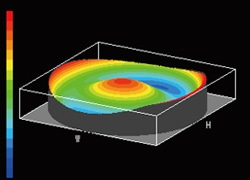
Bad wave front
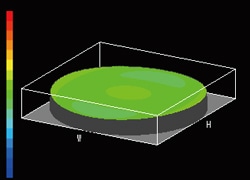
Good wave front
Consistent Color Temperature: High-Intensity White LED Illumination
The MX63 series makes use of a high-intensity white LED light source for reflected and transmitted illumination. The LED maintains a reliable color temperature irrespective of intensity for reliable color reproduction and image quality. The LED system offers efficient, long-life illumination that is suitable for materials science applications.

Color varies with light intensity.

Color is consistent with light intensity and clearer than halogen.
* All images captured using auto exposure
Precise Measurements: Auto Calibration
Like digital microscopes, when using EVIDENT Stream software, automatic calibration is available. Auto calibration helps remove human variability in the calibration process, resulting in more reliable measurements. Auto calibration uses an algorithm that automatically calculates the right calibration from an average of many measurement points. This reduces variance introduced by various operators and maintains steady accuracy, enhancing reliability for standard verification.
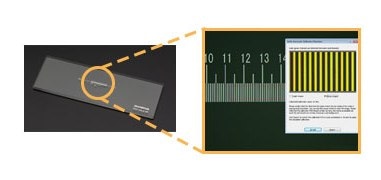
Entirely Clear Image: Image Shading Correction
EVIDENT Stream software features shading correction to house for shading around the corners of an image. When used with intensity threshold settings, shading correction offers a more precise analysis.

Right image: Shading correction produces even illumination across the field of view.
Modularity
Users can tailor their system with the components that match their application.

Fully Customizable
The MX63 series is engineered to enable the customer to select a range of optical components to suit individual inspections and application requirements. The system can utilize all observation techniques. Users can also choose from a range of EVIDENT Stream image analysis packages to match individual image acquisition and analysis requirements.
Two Systems Accommodate Diverse Sample Sizes
The MX63 system can house wafers up to 200 mm while the MX63L system can manage wafers up to 300 mm with the same small footprint as the MX63 system. The modular design makes it easy to tailor the microscope for specific requirements.
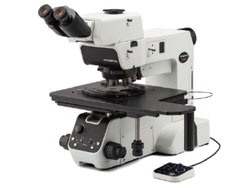
MX63
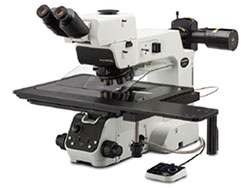
MX63L
IR compatibility
Infrared observation can be done using the IR objective lenses, which enable the operators to non-destructively inspect the inner side of IC chips packed and mounted on a PCB, utilizing the features of silicon that convey infrared light. 5X to 100X IR objectives are available with chromatic aberration correction from visible light wavelengths via the near infrared.
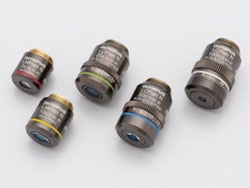
IR objective lenses
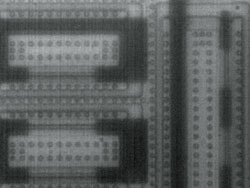
Original image
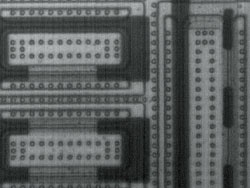
With chromatic aberration
Applications
EVIDENT advanced image management capability pinpoints what users really have to observe.
The MX63 series is used in a variety of reflected light microscopy applications. These applications are an example of a few of the ways the system is used for industrial inspections.
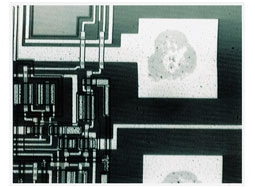
IR image of an electrode section
Infrared (IR) is used to detect defects inside IC chips and other devices made using silicon on glass.

Film
(Left: Brightfield / Right: Polarized light)
Polarized light is used to expose a material’s texture and the condition of crystals. It is ideal for inspections of LCD structures and wafer structures.

A hard disk
(Left: Brightfield / Right: DIC)
Differential interference contrast (DIC) is used to help view samples with miniscule height differences. It is suitable for inspections of samples having very miniscule height differences such as hard-disk media, magnetic heads, and polished wafers.

IC pattern on a semiconductor wafer
(Left: Darkfield / Right: MIX (Brightfield + Darkfield))
Darkfield is used for detecting minute flaws or scratches on a sample or inspecting samples with mirrored surfaces, such as wafers. MIX illumination enables users to view both colors and patterns.

Photoresist residue on a semiconductor wafer
(Left: Fluorescence / Right: MIX (Fluorescence + Darkfield))
Fluorescence is used for samples that discharge light when illuminated with a particularly designed filter cube. This is used to detect photoresist residue and contamination. MIX illumination enables the observation of both the IC pattern and photoresist residue.

An LCD color filter
(Left: Transmitted Light / Right: MIX (Transmitted Light + Brightfield))
This observation method is ideal for transparent samples such as plastics, LCDs, and glass materials. MIX illumination enables the observation of both the circuit pattern and filter color.
Specifications
|
|
MX63 |
MX63L |
| Optical system |
UIS2 optical system (infinity-corrected system) |
| Microscope frame |
Reflected light illumination(FN 26.5) |
White LED(with Light Intensity Manager)12 V 100 W halogen lamp, 100 W mercury lamp
Brightfield/darkfield/mirror cube manual changeover. (Mirror cube is optional.)
3 position coded mirror units changed by manual operation
Built-in motorized aperture diaphragm (Pre-setting for each objective, automatically full open for darkfield)
Observation mode: brightfield, darkfield, differential interface contrast (DIC)*1, simple polarizing*1, fluorescence*1, infra-red*1 and MIX observation(4 directional darkfield)
*1 Optional mirror cube, *2 MIX observation configuration is required |
| Transmitted light illumination(FN 26.5) |
Transmitted light illumination unit MX-TILLA or MX-TILLB is required.
Transmitted light illumination unit with a condenser (NA 0.5) and an aperture stop: MX-TILLA
Transmitted light illumination unit with a condenser (NA 0.6), an aperture stop and a field stop: MX-TILLB
Light source: LG-PS2 (12 V,100 W halogen lamp) Light guide: LG-SF
Observation mode: brightfield, simple polarizing |
| Focus |
Stroke: 32 mm
Fine stroke per rotation: 100 μm
Minimum graduation: 1μm
Upper limit stopper and torque adjustment for coarse handle |
| Maximum load weight(including stage and holder) |
8 kg |
15 kg |
| Observation tube |
Wide-field (FN 22) |
Elect and trinocular: U-ETR4
Elect, tilting and trinocular: U-TTR-2
Inverted and trinocular: U-TR30-2, U-TR30IR (for IR observation)
Inverted and binocular: U-BI30-2
Inverted, tilting and binocular: U-TBI30 |
| Super-wide-field (FN 26.5) |
Elect, tilting and trinocular: MX-SWETTR (optical path switchover 100% (eyepiece) : 0 (camera) or 0 : 100%)
Elect, tilting and trinocular: U-SWETTR (optical path switchover 100% (eyepiece) : 0 (camera) or 20% : 80%)
Inverted and trinocular: U-SWTR-3 |
| Motorized nosepiece |
Brightfield
Motorized sextuple with a slider slot for DIC: U-D6REMC
Motorized centerable quintuple with a slider slot for DIC: U-P5REMC
Brightfield and darkfield
Motorized sextuple with a slider slot for DIC: U-D6BDREMC
Motorized quintuple with a slider slot for DIC: U-D5BDREMC
Motorized centerable quintuple with a slider slot for DIC: U-P5BDREMC
|
| Stage (X × Y) |
Coaxial right handle with built-in clutch drive: MX-SIC8R
Stroke: 210 x 210 mm
Transmitted light illumination area: 189 x 189 mm
Coaxial right handle with built-in clutch drive: MX-SIC6R2
Stroke: 158 x 158 mm
(Reflected light use only)
|
Coaxial right handle with built-in clutch drive: MX-SIC1412R2
Stroke: 356 x 305 mm
Transmitted light illumination area: 356 x 284 mm |
| Weight |
Approx. 50 kg(Microscope frame 37.5 kg) |
Approx. 64 kg(Microscope frame 44.0 kg) |